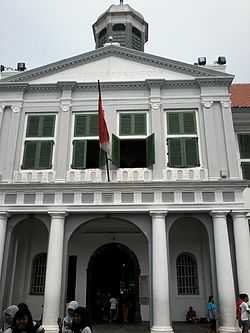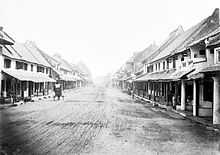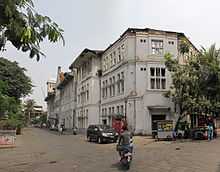Kota, Jakarta

Kota (Indonesian: Kota Tua Jakarta) is a neighborhood comprising the original downtown area of Jakarta, Indonesia. It is also known as Old Jakarta, and Old Batavia (Dutch: Oud Batavia). Kota is the Indonesian word for "city", a reminder of the walled settlement Batavia which gained importance during the 17th-19th century as the de facto capital of the Dutch East Indies. This inner city contrasted with the surrounding kampung (villages), orchards, and ricefields. It spans 1.3 square kilometres of North Jakarta and West Jakarta (Kelurahan Pinangsia, Taman Sari and Kelurahan Roa Malaka, Tambora). The largely Chinese downtown area of Glodok is a part of Kota.
Dubbed "The Jewel of Asia" and "Queen of the East" in the 16th century by European sailors, Old Jakarta – or Batavia, as it was named by the Dutch – was once a center of commerce for the whole archipelago due to its strategic location and abundant resources.
History
.jpg)
Headquarter of Dutch East India company
In 1526, Fatahillah, sent by Sultanate of Demak, invaded the Hindu Pajajaran's port of Sunda Kelapa, after which he renamed it into Jayakarta. This town was only 15 hectare in size and had a typical Javanese harbor lay-out. In 1619 the VOC destroyed Jayakarta under the command of Jan Pieterszoon Coen. A year later the VOC built a new town named "Batavia" after the Batavieren, the Dutch ancestors from antiquity. This city was centered around the east bank of the Ciliwung river, around present day Fatahillah Square. Inhabitants of Batavia are called "Batavianen", later known as "Betawi" people. The creole citizens are descendants of mixed various ethnicities that had inhabited Batavia.
Around 1630 the city expanded towards the west banks of Ciliwung, on the ruins of former Jayakarta. The city was designed in according to Dutch urban planning complete with a fortress (Kasteel Batavia), city wall, public square, churches, canals and tree-lined streets. The city was arranged in several blocks separated by canals. No native Javanese are allowed to live within the city walls, as they were feared for starting an insurrection.[1] The planned city of Batavia was completed in 1650. It became the headquarters of the VOC in the East Indies and prospered from the spice trade.
Old Batavia declined in prominence in the late 18th century, likely because the canals with their near-stagnant water, together with the warm and humid climate would often cause outbreaks of tropical diseases like malaria. Much of the old town became neglected and abandoned due to its ailing nature, and slowly its canals were filled up. Countryside villas were preferred by wealthier residents, which caused the city to grow southward. This process led to the foundation of an estate named Weltevreden.
As capital of Dutch East Indies

The city retained its status as the administrative center of the Dutch East Indies when the VOC transferred its possession to the monarch of the Netherlands in 1800.
During the rule of Governor General Daendels in 1808, the city's administration and military were moved south to Weltevreden, with a new planned town center around Koningsplein and Waterlooplein. Due to financial problems however, much of the old town, its wall, and kasteel Batavia were torn down for construction materials to build new government and civic buildings, such as the palace of Daendels (now department of Finance) and the Harmonie society building (demolished). The only remnant of Kasteel Batavia is Amsterdam Gate, which eventually was completely demolished in 1950.
The city continued to expand further south as epidemics in 1835 and 1870 forced more and more people to move out of the old city to the new spacious, green and healthier Weltevreden neighborhood. The old city became deserted and was a mere empty shell of its former glory by this period. Old Batavia kept its commercial importance as the city's main harbor and warehouses district, but it was largely overshadowed by Surabaya as the colony's prime harbor and commercial hub.
After the opening of Tanjung Priok harbor and fueled by the increasing rubber output in the late 19th century, Batavia was able to regain its commercial momentum. There had been attempts to restore the city's old downtown prominence by converting the desolated area to be the main business district of Batavia. As a result the former mansions and shophouses that at the time had been occupied by ethnic Chinese people, were converted and renovated into offices in 1900-1942. Many of these offices can still be seen today around Kali Besar. The development of the business district was hampered by the 1930 Great Depression and the Japanese occupation of Indonesia in 1942.
Post Independent Indonesia

After the recognition of Indonesia's independence in 1950, the business district was moved to Thamrin and Kebayoran Baru in the south, thus allowing the old city to further deteriorate again after having regained some of its lost glory.
In 1972, the Governor of Jakarta, Ali Sadikin, issued a decree that officially designated the Jakarta Kota area as a heritage site. The governor's decision was necessary in order to preserve the city's architectural roots – or at least what was left of it. Despite the Governor's Decree, the old town remained neglected. Even though the majority was pleased just by the issuing of the decree, not enough was being done to protect and conserve the legacy from the Dutch colonial era. Many buildings in the old town remain abandoned, and increasing pollution hastened up the dilapidation rate of the old buildings. Some old buildings in Kali Besar were destroyed for development despite its heritage status, such as Hotel Batavia, which was built over an old warehouse.[2]
In 2014 the city's governor Joko Widodo planned to restore the old town's remaining colonial buildings and turned it into a major tourist hub for Jakarta. The project is named "Jakarta Old Town Reborn" (JOTR) and is a cooperation between state-owned enterprises, the municipal government and the private sector.[3] Several building around Taman Fatahillah Square have been restored, such as the old post office which has been renovated and converted into a contemporary museum. Despite of this promising developments, most of the city's crumbling colonial architecture remain in ruins up to this day.[4]
Notable sites




Nowadays, many remaining historical buildings and architecture are steadily deteriorating, but some of the old buildings have been restored to their former glory. However, there is still much hope in restoring the area, especially with aid from various non-profit organizations, private institutions, and the government[5] all stepping up to the plate to rejuvenate Old Jakarta's legacy. In 2007, several streets surrounding Fatahillah square such as Pintu Besar street and Pos Kota street, were closed to vehicles as a first step towards the rejuvenation. Since 2014 the old town has a brighter future with the ambitious JOTR project to restore Old Batavia's architecture and putting the site on the UNESCO heritage list.[6]
As an important city and commerce hub in Asia since the 16th century, Oud Batavia is home to several important historical sites and buildings:[1]
- Luar Batang Mosque
- The Port of Sunda Kelapa
- Pasar Ikan (Fish Market)
- Maritime Museum and Menara Syahbandar
- Kota Intan Drawbridge (the only surviving Dutch drawbridge in Indonesia)
- Kali Besar (Groote Gracht, the main business district of old Batavia)
- Gereja Sion (Oldest surviving church structure in Jakarta)
- Gereja Tugu
- Wayang Museum (former Museum of Old Batavia)
- Fine Art and Ceramic Museum (Former Court of Justice of Batavia)
- Jakarta History Museum (Former City Hall of Batavia)
- Cafe Batavia
- Toko Merah (former mansion of Governor General Baron Van Imhoff)
- National Archives of Indonesia (former mansion of Governor General Reynier de Klerck)
- Jakarta Kota Post Office
- Chartered Bank of India, Australia and China (Now owned by Bank Mandiri)
- Dutch East Indies Escompto Bank
- Bank Indonesia Museum (former Javasche Bank, the main bank of the Dutch East Indies)
- Bank Mandiri Museum (former Netherlands Trading Society (Dutch: Nederlandsche Handelsmaatschappij or NHM))
- Jakarta Kota Station (Beos Station)
- Glodok and Pinangsia Area (Jakarta Chinatown)
- Petak Sembilan
- Jin De Yuan Temple (Vihara Dharma Bhakti, the oldest Buddhist temple in Jakarta)
- Hui Tek Bio Temple
- Chandranaya Building (former Chinese Chamber of Commerce, lies beneath Novotel Gajah Mada)
Gallery
-

View of the Stadhuisplein or Taman Fatahillah from the air in 1920s.
-

View of Kali Besar from the air in 1930s.
-

Aerial view of Stationsplein in 1930s.
-

View Kali Besar Canal (Groote Gracht), 1931.
-

Former Batavia city hall, 1932.
-

Stadhuisplein, now Taman Fatahillah in 1930s.
-

Stationsplein in Batavia, overlooking the NHM building (Museum Bank Mandiri).
-

BEOS Station in 1930s.
-

Red Shop/Toko Merah in 1932.
-

The Chartered Bank of India, Australia and China in 1921.
-

former headquarters of the Javasche Bank, now Bank Indonesia's museum in 1938.
-

One of the few surviving VOC era residences in Roa Malacca, 1921.
-

Chinese shops and houses of Old Batavia in 1932, today's Jalan Kunir.
References
- ↑ 1.0 1.1 Kota Tua Jakarta booklet, Dinas Kebudayaan dan Permuseuman Pemerintah Provinsi DKI Jakarta
- ↑ 75% of Old Town Crumbling -- No Incentive from the Government, Kompas, March 6, 2006
- ↑ New Life for an Old Town, forbesindonesia, May 4, 2014
- ↑ The rebirth of Jakarta’s Old Town, thejakartapost, July 23, 2014
- ↑ Old Town Revitalization Becomes a Priority for Provincial Gov't of DKI Jakarta, Kompas, June 10, 2006
- ↑ Kota Tua strong contender UNESCO heritage nominees list, thejakartapost, February 4, 2015
| Wikimedia Commons has media related to Kota, Jakarta. |